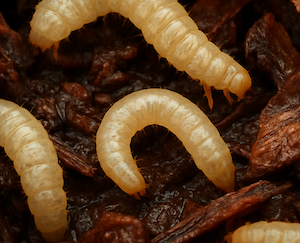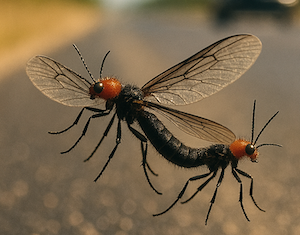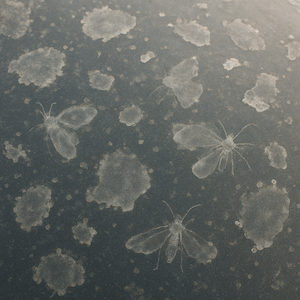The Stain That Came After — a Glimpse of Wonder entry™ —
The first thing you notice is the speckled mess across your windshield. Not bird droppings. Not pollen. It’s worse — splattered lovebugs, baked in by the sun. Their fragile bodies hit like a whisper but dry like epoxy. Wait too long, and you’ll need more than elbow grease. You’ll need new paint.
Most people associate the lovebug with Florida. But it’s not just Florida — these insects swarm across the southeastern United States, including Texas, Louisiana, Alabama, Georgia, and Mississippi. Every May and September, they rise in black clouds, mating in midair and colliding with traffic like tiny kamikazes. But what many don’t realize is that their greatest work doesn’t happen in the skies. It happens underground — long before the swarms.
As larvae, lovebugs (Plecia nearctica) are hidden from view, quietly crawling through damp soil, feasting on the fallen and the forgotten. Decaying leaves. Grass clippings. Mulch. Their job? Breakdown and rebuild. They are some of Jehovah’s unseen recyclers, transforming dead plant matter into rich, aerated soil. According to entomologists at the University of Florida, this natural composting role helps enrich the ground, support healthy root systems, and reduce the buildup of rot and fungi in wet environments. All before they ever take flight.
Decaying leaves. Grass clippings. Mulch. Their job? Breakdown and rebuild. They are some of Jehovah’s unseen recyclers, transforming dead plant matter into rich, aerated soil. According to entomologists at the University of Florida, this natural composting role helps enrich the ground, support healthy root systems, and reduce the buildup of rot and fungi in wet environments. All before they ever take flight.
And once they do, it’s only for a few days. Adult lovebugs don’t bite or sting. They don’t eat. They live for one reason: to reproduce. Males and females spend their final hours locked together at the abdomen, joined tail-to-tail in a physical bond that lasts until the male dies — sometimes even midair. Yet they fly in remarkable coordination, as though moving with shared instinct: one leading, the other balancing. Jehovah crafted a coupling system that keeps them attached without injury — even in wind and speed. It’s a silent sky-dance of unity and purpose.
Males and females spend their final hours locked together at the abdomen, joined tail-to-tail in a physical bond that lasts until the male dies — sometimes even midair. Yet they fly in remarkable coordination, as though moving with shared instinct: one leading, the other balancing. Jehovah crafted a coupling system that keeps them attached without injury — even in wind and speed. It’s a silent sky-dance of unity and purpose.
They’re especially drawn to vibration, heat, and hydrocarbons — the smells and rhythms of car engines and exhaust. The pavement around highways mimics the chemical signals of their natural egg-laying sites. They were here long before Ford invented the automobile, so roads aren’t their design — but ours. Yet roads become mass lovebug traps.
And that creates more than just a nuisance. In peak season, entire windshields can become so smeared with bug remains that visibility drops dangerously low. It’s not hypothetical — swarms have caused drivers to pull over mid-journey or swerve suddenly in panic. In some areas, radiators have clogged, engines have overheated, and crashes have followed. What began as a humble creature doing its job became — unintentionally — a hazard.
And even for those who avoid a wreck, there’s the aftermath.
When lovebugs hit a windshield, their bodies rupture. The enzymes and hemolymph (the insect version of blood) react to heat, creating a mildly acidic, sticky residue. Left alone, that residue can etch the clear coat, pucker the paint, and scar a surface built to endure rain, sun, and speed. If not removed within 24 hours, the damage may be permanent. In some cases, you can still see their outline days after they’re gone.
That’s what struck me most — not just the insect on the glass, but the truth underneath.
One tiny bug hits with barely a sound… yet if you don’t wipe it away, it can leave a mark that lasts.
What other insect leaves a visible reminder of its presence days after it’s gone?
What small, silent thing could cause so much damage — just by being left alone?
And if it happens on a car… could it happen in a heart?
 A careless word. A slow-growing grudge. Even a glimpse of pornography. These things don’t always scream for attention at first. But give them heat and time, and they’ll dig in like lovebug goo on a rental car — the kind you swore you’d return clean. What’s building up in us, right now, that we’ve been “meaning to deal with later”? What damage is waiting to dry?
A careless word. A slow-growing grudge. Even a glimpse of pornography. These things don’t always scream for attention at first. But give them heat and time, and they’ll dig in like lovebug goo on a rental car — the kind you swore you’d return clean. What’s building up in us, right now, that we’ve been “meaning to deal with later”? What damage is waiting to dry?
Jehovah doesn’t just offer forgiveness — he offers help before things set in.
Are we taking him up on that? Or are we hoping the mess will just wash off on its own?
Create in me a pure heart, O God,” David wrote, “and put within me a new spirit” (Psalm 51:10, NWT). That prayer still matters — not once, but often.
References
Journal of the Florida Entomological Society, 2000, “Biology and Behavior of the Lovebug”
University of Florida Entomology Notes, 2003, “Lovebugs: More Than Just a Nuisance”
McGill Office for Science and Society, 2017, “Why Lovebug Splatter Damages Your Car” (mcgill.ca)
Florida Polytechnic University, 2020, “Florida Poly Students Work to Make Lovebugs Less of a Nuisance”
Axios Tampa Bay, 2022, “Lovebug Season in Florida, Explained”
MySuncoast News, 2019, “Lovebugs Invade Suncoast”




2 Comments
Recommended Comments
Join the conversation with your brothers and sisters!
You are posting as a guest. If you are already a member, sign in now to post with your existing account.
Note: Your post will require moderator approval before it will be visible.